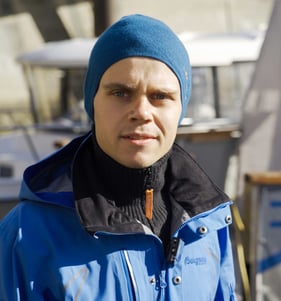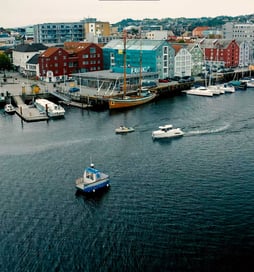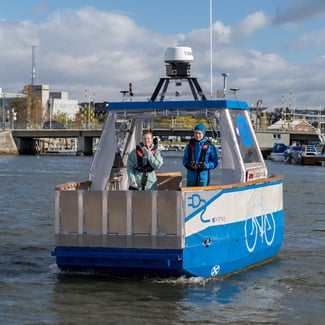Remotely Controlled Ferry Demonstrated at Nyhavna – Successful Test of Groundbreaking Technology
A milestone in maritime technology was marked today as PhD candidate Aleksey...
Last week Ocean Autonomy Cluster (OAC) was invited to come out to Ravnkloa to see milliAmpere and the students who are working on the project. We were even lucky enough to join them out on the sea, and witness the experiments first hand.
The goal from these experiments was to collect data.

— I wish to collect a good data set for sensor fusion. Today will be the first opportunity to collect data with all of the cameras. milliAmpere has 10 cameras in total. We have five ordinary cameras and five infrared cameras. In addition we have one radar and one lidar on the top of the vessel. The cameras have been a little unstable, but now they are all working, says PhD student Øystein Helgesen
This week two groups have been allowed to work on milliAmpere, in addition to Øystein, we also met two master students, Magne Sirnes and Ingunn Kjønås. The master students are working together on collecting data, and will be working on joint tracking and localization as their main project.
— We also need to collect data this week. If we are lucky we get data that overlaps with the ground station. Together we hope to be able to assemble the data as we go along so we can work on tracking and SLAM (Simultaneous Localization And Mapping) says Magne Sirnes.

The last days have been spent out on the sea and inside their test site by Fosenkaia in Trondheim. To collect data they take milliAmpere and two trailing boats out for testing. Together they coordinate different experiments, and all of the vessels drive in a specific pattern so they can collect data from different situations. The trailing boats are equipped with GPS so the students can get the exact position from where the trailing boats were in relation to milliAmpere at any given time during each experiment. Together with the ground station these experiments will give the students a lot of data to continue working with. They have already collected about 200GB!
— This is our last day, tomorrow there will be new students to collect data. When we are done today the real work starts. We have to coordinate the collected data, process it, synchronize GPS data from the other vessels and analyze the data before working on sensor fusion, says Ingunn Kjønås.

It’s a difficult task to achieve sensor fusion, but luckily they have time to analyze the results from today. Øystein has already achieved some success with other data sets and is looking forward to continuing working with new data. All three students were excited to be doing something practical in connection to their papers and master thesis.
— It has been super fun to be doing something practical and getting real data instead of just sitting inside. We have also seen how for example the weather has had an impact on our data sets. Yesterday it was raining and we can clearly see that it had an impact on our sensors, says Kjønås.
Magne and Øystein are nodding and adds:
— We get to collect data, but it’s also very fun to be able to experiment with high technology equipment that not many other students get to use. We had some trouble with the equipment a couple of days ago, but we got it all working again. It takes some time to fix but, but we expected to use some time to get to know the equipment on the boat, and on the ground station.
It’s these students’ last day, but they are open to taking milliAmpere out again later if the opportunity presents itself, and the experiments from last week turn out to yield results.
We wish all of them good luck with the fusion, and we hope they got all the data they needed!
A milestone in maritime technology was marked today as PhD candidate Aleksey...
Together with Digital innovation HUB Innovamare in Croatia, Ocean Autonomy Cluster (OAC) have...
One small ROV, developed by cluster member Blueye Robotics, is saving Equinor millions of NOK in...